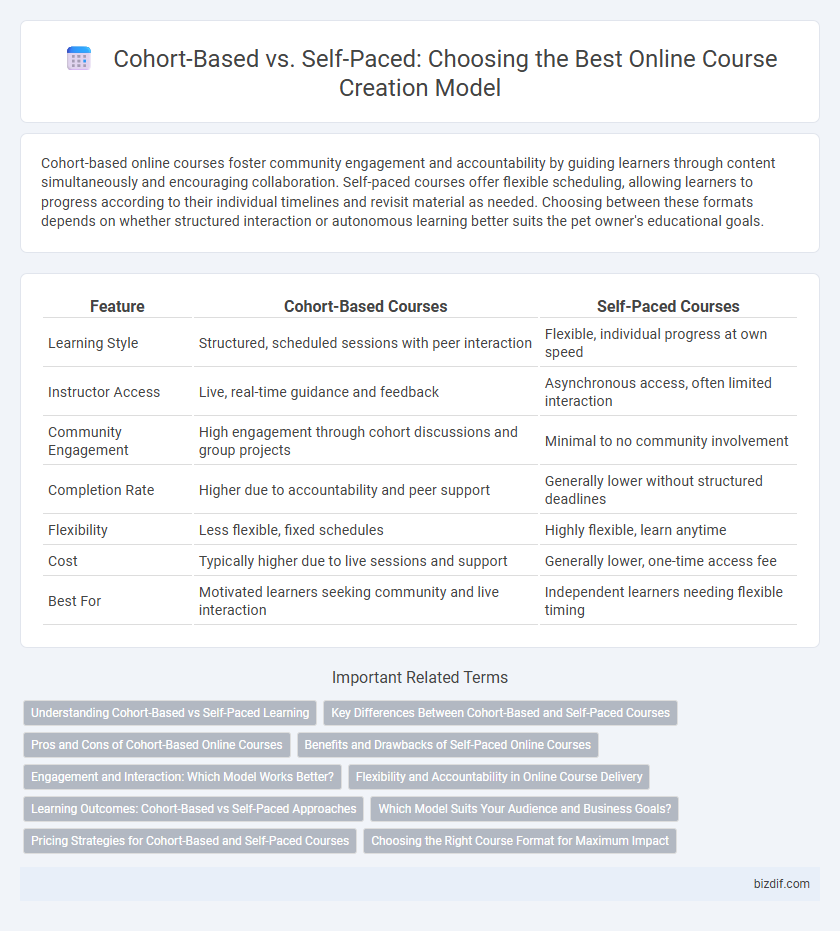Cohort-based online courses foster community engagement and accountability by guiding learners through content simultaneously and encouraging collaboration. Self-paced courses offer flexible scheduling, allowing learners to progress according to their individual timelines and revisit material as needed. Choosing between these formats depends on whether structured interaction or autonomous learning better suits the pet owner's educational goals.
Table of Comparison
| Feature | Cohort-Based Courses | Self-Paced Courses |
|---|---|---|
| Learning Style | Structured, scheduled sessions with peer interaction | Flexible, individual progress at own speed |
| Instructor Access | Live, real-time guidance and feedback | Asynchronous access, often limited interaction |
| Community Engagement | High engagement through cohort discussions and group projects | Minimal to no community involvement |
| Completion Rate | Higher due to accountability and peer support | Generally lower without structured deadlines |
| Flexibility | Less flexible, fixed schedules | Highly flexible, learn anytime |
| Cost | Typically higher due to live sessions and support | Generally lower, one-time access fee |
| Best For | Motivated learners seeking community and live interaction | Independent learners needing flexible timing |
Understanding Cohort-Based vs Self-Paced Learning
Cohort-based learning fosters community engagement and real-time interaction by guiding learners through a course simultaneously, which enhances accountability and motivation. Self-paced learning offers flexibility, enabling students to progress according to their own schedules, ideal for those balancing work or personal commitments. Understanding these variations helps educators and learners select an approach aligning with their goals, engagement preferences, and time management needs.
Key Differences Between Cohort-Based and Self-Paced Courses
Cohort-based courses emphasize synchronized learning with fixed start and end dates, fostering peer interaction and structured progress through collaborative activities and scheduled live sessions. In contrast, self-paced courses offer flexible access, allowing learners to progress independently at their own speed, ideal for those needing customizable timing without real-time deadlines. Key differences include engagement level, with cohort-based promoting accountability and community, while self-paced prioritizes convenience and personalization.
Pros and Cons of Cohort-Based Online Courses
Cohort-based online courses foster community engagement and accountability by having participants follow a shared schedule, which enhances motivation and peer learning. However, they may limit flexibility for learners with busy or unpredictable schedules, potentially reducing accessibility. This structure often results in higher completion rates but requires more coordination and commitment from both instructors and students.
Benefits and Drawbacks of Self-Paced Online Courses
Self-paced online courses offer learners the flexibility to study at their own convenience, accommodating diverse schedules and learning speeds, which enhances accessibility and personalized pacing. These courses often feature comprehensive materials and allow repeated review, promoting deeper understanding but may lack real-time interaction and immediate feedback, potentially reducing learner engagement and accountability. The absence of a structured timeline can lead to procrastination, requiring strong self-motivation and discipline to complete the course successfully.
Engagement and Interaction: Which Model Works Better?
Cohort-based online courses foster higher student engagement and interaction by encouraging real-time discussions, collaborative projects, and peer feedback within a structured timeline, enhancing accountability and motivation. Self-paced courses offer flexibility but often lack consistent interaction, potentially leading to lower engagement and completion rates. Platforms like Teachable and Thinkific highlight that cohort-based models typically yield better learner satisfaction and course completion due to their interactive community dynamics.
Flexibility and Accountability in Online Course Delivery
Cohort-based online courses offer structured flexibility by setting fixed start and end dates, fostering accountability through scheduled interactions and peer support. Self-paced courses provide maximum flexibility, enabling learners to access content and progress on their own schedule, though they often lack built-in mechanisms for accountability. Balancing flexibility with accountability is critical for effective online course delivery, influencing learner engagement and completion rates.
Learning Outcomes: Cohort-Based vs Self-Paced Approaches
Cohort-based courses foster collaborative learning and accountability, often resulting in higher completion rates and deeper understanding of complex topics. Self-paced courses offer flexibility and personalized learning paths, enabling students to progress according to their schedules and retain information at their own speed. The choice between cohort-based and self-paced models significantly impacts learner engagement, knowledge retention, and overall learning outcomes.
Which Model Suits Your Audience and Business Goals?
Cohort-based courses foster engagement and community, ideal for learners seeking structured schedules and peer interaction, boosting completion rates and accountability. Self-paced courses offer flexibility and accessibility, appealing to busy professionals and diverse learning preferences, enabling scalable revenue without time constraints. Aligning the course model with your audience's learning habits and your business goals ensures maximum impact and profitability.
Pricing Strategies for Cohort-Based and Self-Paced Courses
Cohort-based courses typically command higher price points due to their limited enrollment, live interaction, and community engagement, often ranging from $500 to over $2,000 per course. Self-paced courses usually adopt a more accessible pricing model, generally between $50 and $500, leveraging automation and scalability to attract a larger audience. Pricing strategies must balance perceived value and completion rates, with cohort-based models justifying premium pricing through personalized support and networking opportunities.
Choosing the Right Course Format for Maximum Impact
Cohort-based courses foster collaboration and accountability through scheduled live sessions, enhancing learner engagement and completion rates. Self-paced courses offer flexibility, allowing students to learn on their own schedule, making them ideal for busy professionals. Selecting the right format depends on your target audience's needs and your goals for interaction, retention, and course completion.
Cohort-based vs Self-paced Infographic

 bizdif.com
bizdif.com